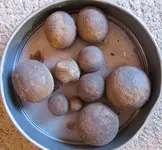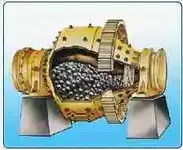Pistol-pete, your deduction is correct... they are Mill-Balls. Being out-of-round eliminates all the other possibilities. For example, cannonballs HAD to be manufactured as True-Spheres, because an out-of-round one can jam in the barrel during loading or firing ...and either one is bad news for the cannon's crew.
Jamming during loading means you're getting shot at but can't shoot back -- for however long it takes you to manage to "worm" the stuck projectile out of the cannon's barrel. Jamming during firing can cause the cannon itself to burst, violently, killing or injuring the crew. So, part of an Ordnance Inspector's job was to carefully used what are called "Ring Guages" to make sure EVERY cannonball issued to the cannoneers was perfectly round. (But a tiny casting-mold seam on the ball didn't matter.)
For anybody here who doesn't know what Mill-Balls are, and how they are used:
The least laborious way to crush/pulverize hard materials (like rocks, metal-ore, coal, etc) is to put the hard material into a Tumbler-Mill (which is basically just a large barrel), along with a bunch of iron or steel balls. You then rotate the barrel on its axis. The metal balls crush the rocks as they all tumble around inside the barrel while it spins. It's the simplest way to turn big rocks into little rocks (or dust). Using a Tumbler-Mill is MUCH less laborious than having a workman bash each of the rocks with a sledgehammer. See the descriptive image (below).
The important thing about that for relic-hunters is:
The manufacture of cannonballs ceased about 140 years ago. But Mill-Balls also date from olden times and have continued to be manufactured right up to today. Lliterally multi-millions of Mill-Balls have been produced for Industrial use.
Important note: Most Mill-Balls are round, not just egg-shaped like Pistol-pete found.
How to distinguish a Mill-Ball from an artillery ball:
1- Super-precisely measure the ball's weight (in pounds-&-ounces) and its diameter (in hundredths-of-an-inch).
2- Then see if that ball's very-exact weight and diameter measurements match anything in the Shot Tables charts from the USA (and Confederate) Ordnance Manual. To view the Shot Tables charts online, for free, go to:
www.civilwarartillery.com/shottables.htm
Here's a detailed set of instructions for telling a cannonball from a Mill-Ball, or a ball-bearing, or a Sports Shot Put ball, etc:
http://www.pochefamily.org/books/SolidShotEssentialsMod.html
Here's the descriptive image of a Tumbler-Mill, using the mill-balls.






